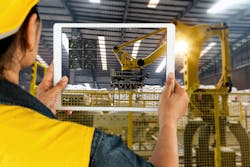Is Wide-Spread Use of AI & Machine Intelligence in Manufacturing Still Years Away?
According to a new report by PMMI Business Intelligence, artificial intelligence (AI) and machine learning is the area of automation technology with the greatest capacity for expansion. This technology can optimize individual processes and functions of the operation; manage production and maintenance schedules; and, expand and improve the functionality of existing technology such as vision inspection.
While AI is typically aimed at improving operation-wide efficiency, machine learning is directed more toward the actions of individual machines; “learning” during operation, identifying inefficiencies in areas such as rotation and movement, and then adjusting processes to correct for inefficiencies.
The advantages to be gained through the use of AI and machine learning are significant. One study released by Accenture and Frontier Economics found that by 2035, AI-empowered technology could increase labor productivity by up to 40%, creating an additional $3.8 trillion in direct value added (DVA) to the manufacturing sector.
See it Live at PACK EXPO Connects Nov. 9-13: End-of-Line Automation without Capital Expenditure, by Pearson Packaging Systems. Preview the Showroom Here.
However, only 1% of all manufacturers, both large and small, are currently utilizing some form of AI or machine learning in their operations. Most manufacturers interviewed said that they are trying to gain a better understanding of how to utilize this technology in their operations, and 45% of leading CPGs interviewed predict they will incorporate AI and/or machine learning within ten years.
A plant manager at a private label SME reiterates AI technology is still being explored, stating: “We are only now talking about how to use AI and predict it will impact nearly half of our lines in the next 10 years.”While CPGs forecast that machine learning will gain momentum in the next decade, the near-future applications are likely to come in vision and inspection systems. Manufacturers can utilize both AI and machine learning in tandem, such as deploying sensors to key areas of the operation to gather continuous, real-time data on efficiency, which can then be analyzed by an AI program to identify potential tweaks and adjustments to improve the overall process.
See it Live at PACK EXPO Connects Nov. 9-13: Reduce costs and improve product quality in adhesive application of primary packaging, by Robatech USA Inc. Preview the Showroom Here.
And, the report states, that while these may appear to be expensive investments best left for the future, these technologies are increasingly affordable and offer “solutions that can bring measurable efficiencies to smart manufacturing.” In the days of COVID-19, gains to labor productivity and operational efficiency may be even more timely.
To access this FREE report and learn more about automation in operations, download below.
Source: PMMI Business Intelligence, “Automation Timeline: The Drive Toward 4.0 Connectivity in Packaging and Processing”
PACK EXPO Connects – November 9-13. Now more than ever, packaging and processing professionals need solutions for a rapidly changing world, and the power of the PACK EXPO brand delivers the decision makers you need to reach. Attendee registration is open now.

